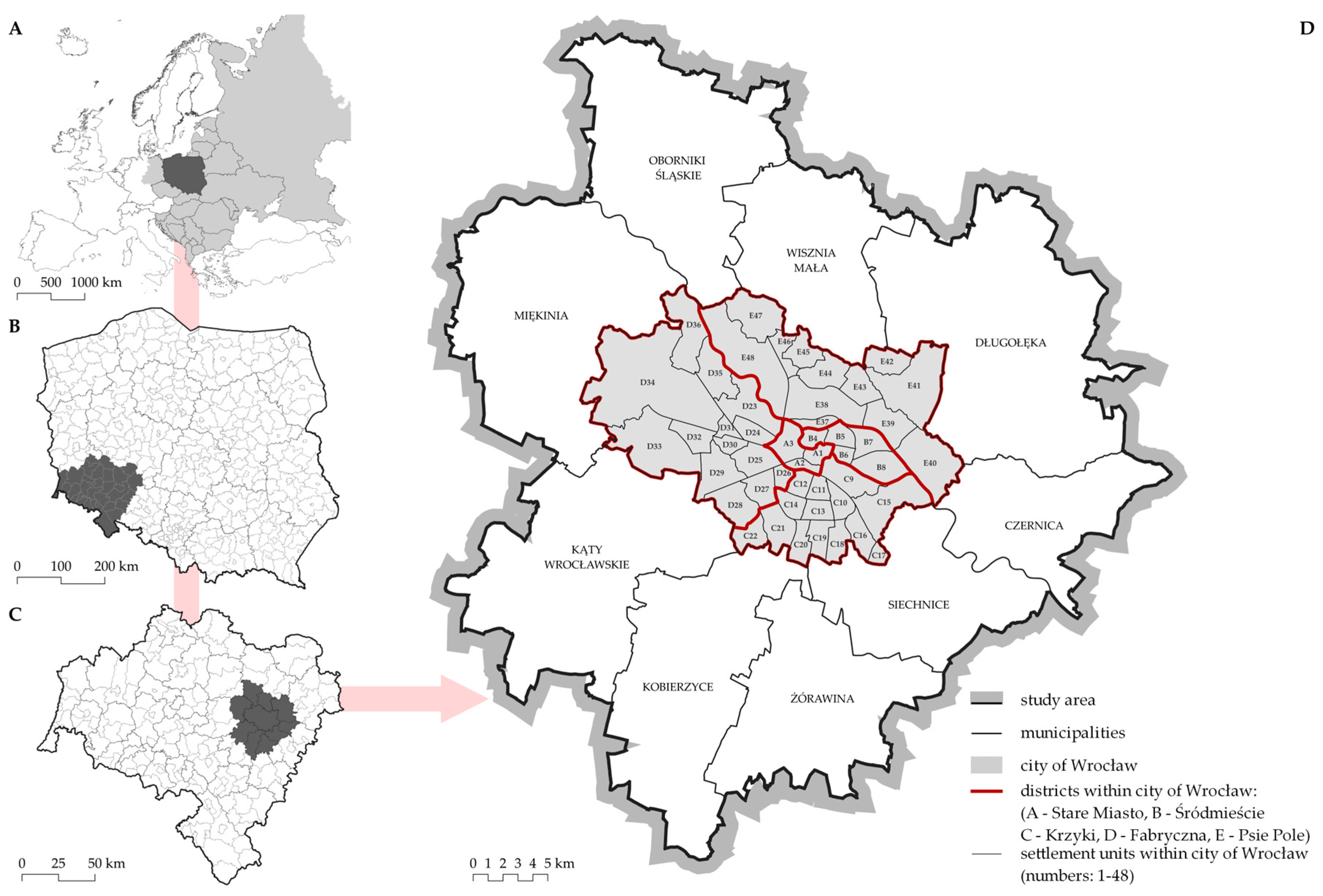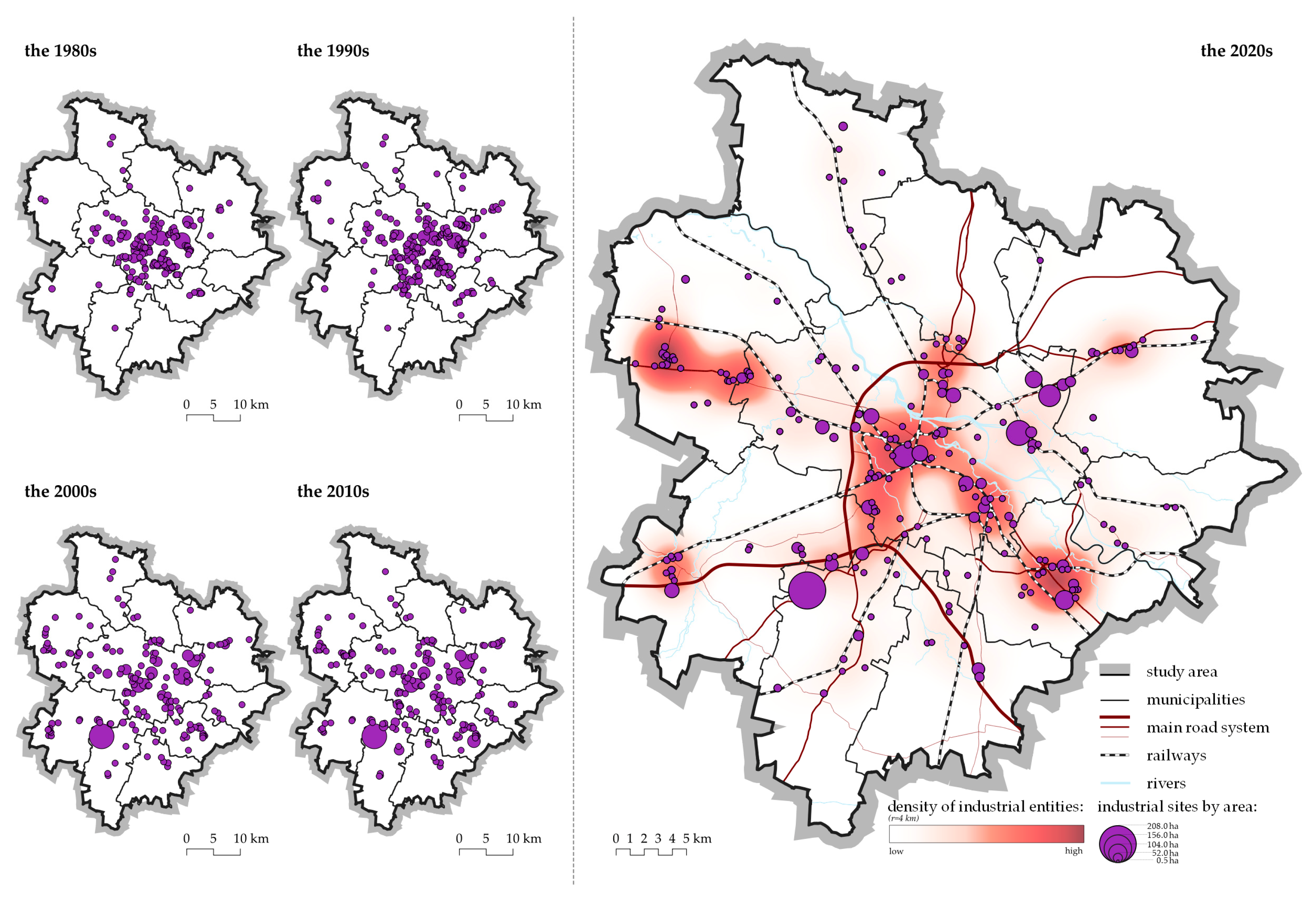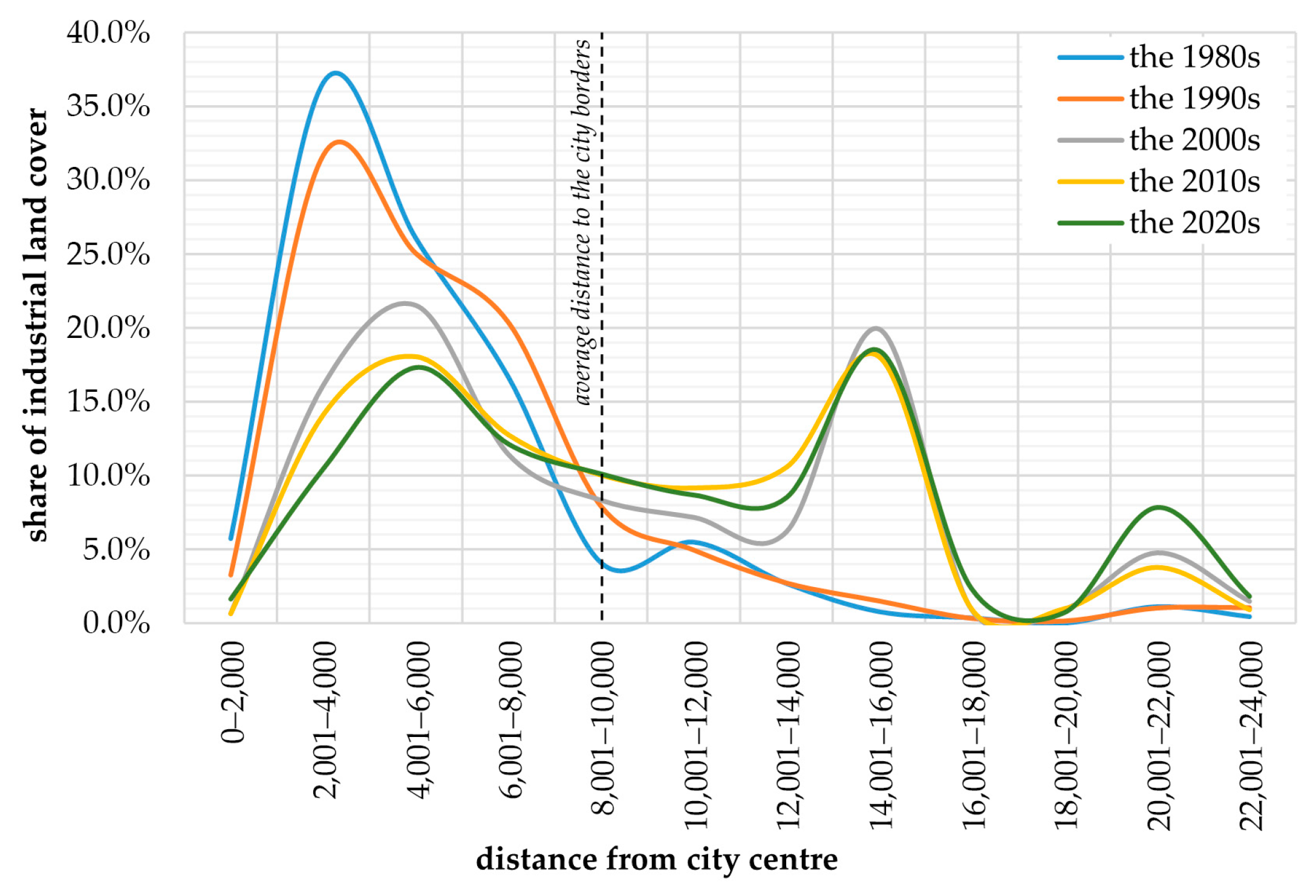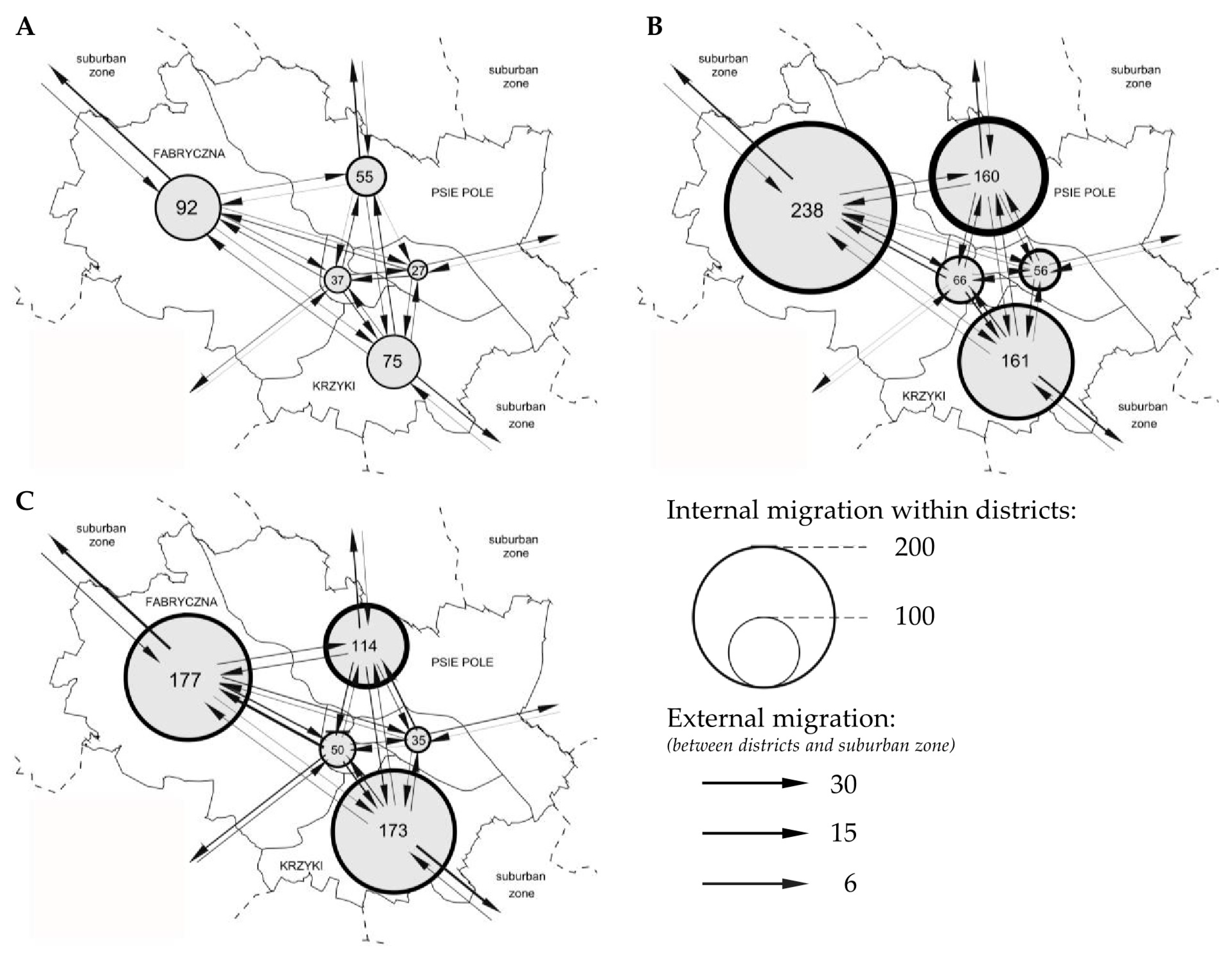Deconcentration of Industrial Activity as a Constituent of Sustainable Urban Development in a Post-Socialist City: A Case Study of Wroclaw, Poland
Abstract
1. Introduction
2. Materials and Methods
2.1. Study Area
2.2. Research Design
3. Results
3.1. Dynamics of Spatial Distribution
3.2. Dynamics of Industrial Entities
4. Discussion
5. Conclusions
- The significant deconcentration of industrial activity commenced after 1989, resulting in substantial shifts in industry distribution across the city–suburban zone;
- The peak of these changes occurred in the 1990s, driven more by the decline of unprofitable industrial activities within the city [15] than by a deliberate deconcentration strategy;
- The requirements for industry deconcentration began to gain importance in the economic and spatial policies of CEE countries only in the late 1990s [62], leading to the gradual implementation of the idea of sustainable urban development;
- The processes of industrial deconcentration in post-socialist cities are ongoing, although not at the same scale as in earlier years.
Author Contributions
Funding
Institutional Review Board Statement
Informed Consent Statement
Data Availability Statement
Conflicts of Interest
References
- Cudny, W.; Kunc, J. (Eds.) Growth and Change in Post-Socialist Cities of Central Europe; Routledge: London, UK; New York, NY, USA, 2022. [Google Scholar]
- Kovács, Z. Cities from state-socialism to global capitalism: An introduction. GeoJournal 1999, 49, 1–6. Available online: https://www.jstor.org/stable/41147394 (accessed on 1 September 2023). [CrossRef]
- Cudny, W. Socio-Economic Changes in Lodz—Results of Twenty Years of System Transformation. Geogr. Časopis 2012, 64, 3–27. [Google Scholar]
- Liszewski, S. Model przemian przestrzeni miejskiej miasta postsocjalistycznego. In Miasto Postsocjalistyczne—Organizacja Przestrzeni Miejskiej i Jej Przemiany; Jazdzewska, I., Ed.; Konwersatorium Wiedzy o Mieście 2001, XIV; Uniwersytetu Łódzkiego: Łódź, Poland, 2001; pp. 303–310. [Google Scholar]
- Ondoš, S.; Korec, P. The rediscovered city: A case study of post-socialist Bratislava. Geogr. Cas. 2008, 60, 199–213. [Google Scholar]
- Sýkora, L. Post-socialist cities. In International Encyclopedia of Human Geography; Kitchin, R., Thrift, N., Eds.; Elsevier: Oxford, UK, 2009; pp. 387–395. [Google Scholar] [CrossRef]
- Jürgens, U. City profile Leipzig. Cities 1996, 13, 37–43. [Google Scholar] [CrossRef]
- Mulícek, O.; Toušek, V. Changes of Brno industry and their urban consequences. Bull. Geogr. 2004, 3, 61–70. [Google Scholar] [CrossRef]
- Osman, R.; Frantál, B.; Klusácek, P.; Kunc, J.; Martinát, S. Factors affecting brownfield regeneration in post-socialist space: The case of the Czech Republic. Land Use Policy 2015, 48, 309–316. [Google Scholar] [CrossRef]
- Kovács, Z.; Wiessner, R.; Zischner, R. Urban renewal in the inner city of Budapest: Gentrification from a post-socialist perspective. Urban Stud. 2013, 50, 22–38. [Google Scholar] [CrossRef]
- Kaczmarek, S. Skuteczność procesu rewitalizacji. Uwarunkowania, mierniki, perspektywy. Stud. Miej. 2015, 17, 27–35. Available online: http://www.studiamiejskie.uni.opole.pl/wp-content/uploads/2016/05/S_Miejskie_17_2015-Kaczmarek.pdf (accessed on 2 September 2023).
- Holm, A.; Marcińczak, S.; Ogrodowczyk, A. New-build gentrification in the postsocialist city: Łodź and Leipzig two decades after socialism. Geografie 2015, 120, 164–187. [Google Scholar] [CrossRef]
- Chapain, C.; Stryjakiewicz, T. (Eds.) Creative Industries in Europe: Drivers of New Sectoral and Spatial Dynamics; Springer: Cham, Switzerland, 2017. [Google Scholar]
- Chaloupková, M.; Kunc, J.; Dvorák, Z. The creativity index growth rate in the czech republic: A spatial approach. Geogr. Tech. 2018, 13, 30–40. [Google Scholar] [CrossRef]
- Sikorski, D. Proces sukcesji funkcjonalnej na terenach przemysłowych i poprzemysłowych w miastach województwa dolnośląskiego. In Studium Przypadków, Wydawnictwo Uczelniane PWSZ im; A Silesiusa: Wałbrzych, Poland, 2013. [Google Scholar]
- Sikorski, D. Wybrane Kierunki i Aspekty Przemian Funkcjonalnych Terenów Przemysłowych we Wrocławiu w Latach 1989–2016; Prace Komisji Geografii Przemysłu PTG: Warsaw, Poland, 2019; Volume 33, pp. 227–240. [Google Scholar] [CrossRef]
- Jacobs, A. The Bratislava metropolitan region. Cities 2013, 31, 507–514. [Google Scholar] [CrossRef]
- Bucek, J.; Bleha, B. Urban shrinkage as a challenge to local development planning in Slovakia. Morav. Geogr. Rep. 2013, 21, 2–15. [Google Scholar] [CrossRef][Green Version]
- Rink, D.; Couch, C.; Haase, A.; Krzysztofik, R.; Nadolu, B.; Rumpel, P. The governance of urban shrinkage in cities of post-socialist Europe: Policies, strategies and actors. Urban Res. Pract. 2014, 7, 258–277. [Google Scholar] [CrossRef]
- Lisowski, A.; Mantey, D.; Wilk, W. Lessons from Warsaw: The lack of co-ordinated planning and its impacts on urban sprawl. In Confronting Suburbanization: Urban Decentralization in Postsocialist Central and Eastern Europe; Stanilova, K., Sýkora, L., Eds.; Wiley-Blackwe: Oxford, UK, 2014; pp. 225–255. [Google Scholar] [CrossRef]
- Pichler-Milanović, N. Confronting suburbanization in Ljubljana: From “urbanization of the countryside” to urban sprawl. In Confronting Suburbanization: Urban Decentralization in Postsocialist Central and Eastern Europe; Stanilova, K., Sýkora, L., Eds.; Wiley-Blackwe: Oxford, UK, 2014; pp. 65–96. [Google Scholar] [CrossRef]
- Stanilov, K.; Hirt, S. Sprawling Sofia: Postsocialist suburban growth in the Bulgarian capital, In Confronting Suburbanization: Urban Decentralization in Postsocialist Central and Eastern Europe; Stanilova, K., Sýkora, L., Eds.; Wiley-Blackwe: Oxford, UK, 2014; pp. 163–191. [Google Scholar] [CrossRef]
- Kovács, Z.; Farkas, J.Z.; Egedy, T.; Kondor, A.C.; Szabó, B.; Lennert, J.; Baka, D.; Kohán, B. Urban sprawl and land conversion in post-socialist cities: The case of metropolitan Budapest. Cities 2019, 92, 71–81. [Google Scholar] [CrossRef]
- Grigorescu, I.; Mitrica, B.; Kucsicsa, G.; Popovici, E.A.; Dumitrascu, M.; Cuculici, R. Post-communist land use changes related to urban sprawl in the Romanian metropolitan areas. Hum. Geogr. J. Stud. Res. Hum. Geogr. 2012, 6, 35–46. [Google Scholar] [CrossRef]
- Šveda, M.; Madajová, M.; Podolák, P. Behind the differentiation of suburban development in the hinterland of Bratislava, Slovakia. Czech Sociol. Rev. 2016, 52, 893–925. Available online: https://www.jstor.org/stable/44817689 (accessed on 2 September 2023). [CrossRef]
- Stanilov, K.; Sýkora, L. Planning markets, and patterns of residential growth in metropolitan Prague. J. Archit. Plan. Res. 2012, 29, 278–291. Available online: https://www.jstor.org/stable/43030982 (accessed on 3 September 2023).
- Sýkora, L.; Ouředníček, M. Sprawling post-communist metropolis: Commercial and residential suburbanization in Prague and Brno, the Czech Republic. In Employment Deconcentration in European Metropolitan Areas; Razin, E., Dijst, M., Vazquez, C., Eds.; Springer: Dordrecht, The Netherlands, 2007; pp. 209–233. [Google Scholar] [CrossRef]
- Leetmaa, K.; Kährik, A.; Nuga, M.; Tammaru, T. Suburbanization in the Tallinn Metropolitan Area. In Confronting Suburbanization: Urban Decentralization in Postsocialist Central and Eastern Europe; Stanilova, K., Sýkora, L., Eds.; Wiley-Blackwe: Oxford, UK, 2014; pp. 192–224. [Google Scholar]
- Kubeš, J. Analysis of regulation of residential suburbanisation in hinterland of postsocialist ‘one hundred thousands’ city of Ceske Budejovice. Bull. Geogr. 2015, 27, 109–131. [Google Scholar] [CrossRef]
- Szmytkie, R. Suburbanisation processes within and outside the city: The development of intra-urban suburbs in Wrocław, Poland. Morav. Geogr. Rep. 2021, 29, 149–165. [Google Scholar] [CrossRef]
- Popescu, C. Deindustrialization and Urban Shrinkage in Romania What Lessons for the Spatial Policy? Transylv. Rev. Adm. Sci. 2014, 10, 181–202. [Google Scholar]
- Popescu, C. After deindustrialisation: Changing urban economy in the Danube valley region. Hum. Geogr. J. Stud. Res. Hum. Geogr. 2016, 10, 99–113. [Google Scholar] [CrossRef]
- Săgeată, R. Commercial services and urban space reconversion in Romania (1990–2007). Acta Geogr. Slov. 2020, 60, 49–60. [Google Scholar] [CrossRef]
- Săgeată, R.; Mitrică, B.; Cercleux, A.-L.; Grigorescu, I.; Hardi, T. Deindustrialization, Tertiarization and Suburbanization in Central and Eastern Europe. Lessons Learned from Bucharest City. Rom. Land 2023, 12, 1731. [Google Scholar] [CrossRef]
- Brezdeń, P.; Szmytkie, R. Current Changes in the Location of Industry in the Suburban Zone of A Post-Socialist City. Case Study of Wrocław (Poland). Tijdschr. Voor Econ. En Soc. Geogr. 2019, 110, 102–122. [Google Scholar] [CrossRef]
- Hamilton, F.E.I.; Andrews, K.; Pichler-Milanović, N. (Eds.) Transformation of Cities in Central and Eastern Europe: Towards Globalization; United Nations University Press: Tokyo, Japan, 2005; Available online: https://chisineu.files.wordpress.com/2012/08/biblioteca_hamilton_transformation.pdf (accessed on 2 September 2023).
- Główny Urząd Statystyczny. National Population and Housing Census (in Polish: Narodowy Spis Powszechny Ludności i Mieszkań); Główny Urząd Statystyczny: Warszawa, Poland, 2021.
- Kulak, T. Historia Wrocławia. Tom II: Od Twierdzy Fredyrecjańskiej do Twierdzy Hitlerowskiej; Wydawnictwo Dolnośląskie: Wrocław, Poland, 2001. [Google Scholar]
- Kulak, T. Wrocław. In Przewodnik Historyczny; Wydawnictwo Dolnośląskie: Wrocław, Poland, 2006. [Google Scholar]
- Książek, S.; Suszczewicz, M. City profile: Wrocław. Cities 2017, 65, 51–65. [Google Scholar] [CrossRef]
- Sikorski, D.; Szmytkie, R. Changes in the distribution of economic activity in Wrocław and its suburban area, 2008–2016. Bull. Geogr. 2019, 54, 33–48. [Google Scholar] [CrossRef]
- Kunc, J.; Sikorski, D.; Novotná, M.; Brezdeń, P.; Ilnicki, D.; Tonev, P.; Marek, A. Industrial legacy towards modern urban environment: A comparative study of Wroclaw and Brno. Bull. Geogr. Socio-Econ. Ser. 2023, 61, 71–92. [Google Scholar] [CrossRef]
- Ilnicki, D. Statystyczna i rzeczywista przestrzeń instytucjonalna miasta. In Struktura Funkcjonalna Małych Miast; Marszał, T., Ed.; Wydawnictwo Uniwersytetu Łódzkiego: Łódź, Poland, 2009; pp. 115–137. [Google Scholar]
- Raczyk, A. Metody badania przedsiębiorczości oparte na rejestrze podmiotów gospodarki narodowej. In Rola Przedsiębiorczości w Kształtowaniu Społeczeństwa Informacyjnego; Zioło, T., Rachwał, T., Eds.; Przedsiębiorczość-Edukacja: Szczecin, Poland, 2009; Volume 5, pp. 133–146. [Google Scholar]
- Śleszyński, P. Studium szacunku liczby i rozmieszczenia pracujących w Krakowie. Biul. Kpzk PAN 2010, 243, 5–102. [Google Scholar]
- Celińska-Janowicz, D. Rejestry podmiotów jako źródła danych w analizach lokalizacji działalności gospodarczej w mikroskali. Wiadomości Stat. 2016, 1, s27–s43. Available online: http://cejsh.icm.edu.pl/cejsh/element/bwmeta1.element.desklight-ec3378c6-f2fb-4907-b24e-8bfa2f1349bf (accessed on 3 September 2023).
- Straszewicz, L. Strefa podmiejska. Pojęcia i definicje. Acta Univ. Lodz. Folia Geogr. 1985, 5, 7–16. [Google Scholar]
- Zathey, M.; Wałęga, A.; Acedońska, K.; Balachowski, J.; Cieślak, R.; Drewnicka, K.; Halicka-Borucka, M.; Kasprzak, M.; Książek, S.; Kukuła, M.; et al. Analiza gospodarcza Dolnego Śląska 2021; Instytut Rozwoju Terytorialnego: Wrocław, Poland, 2021. [Google Scholar]
- Slenczek, M. Miasto Wrocław Jako Ośrodek Przemysłowy; Acta Universitatis Wratislaviensis, Prace Instytutu Geograficznego. Ser. B Geogr. Społeczna I Ekon. 1996, 14, 85–91. [Google Scholar]
- Slenczek, M. Rozwój i przemiany przemysłu na Dolnym Śląsku. In Przemiany Ludnościowo-Osadnicze i Społeczno-Gospodarcze na Dolnym Śląsku po II Wojnie Światowej; Łoboda, J., Ed.; Acta Universitatis Wratislaviensis. Studia Geograficzne; Wydawnictwo Uniwersytetu Wrocławskiego: Wrocław, Poland, 1994; Volume 61, pp. 99–131. [Google Scholar]
- Eagle, D.; Stephanedes, J.Y. Dynamic Highway Impacts on Economic Development. Transp. Res. Rec. 1967, 1116, 56–62. [Google Scholar]
- Rephanna, T.; Isserman, A. New highways as economic development tools: An evaluation using quasi-experimental matching methods. Reg. Sci. Urban Econ. 1994, 24, 723–751. [Google Scholar] [CrossRef]
- Wang, W. Empirical Study on the Relationship between Highway Construction and Economic Growth Based on Big Data Analysis. J. Phys. Conf. Ser. 2021, 1744, 032011. [Google Scholar] [CrossRef]
- Brezdeń, P.; Sikorski, D.; Smętkiewicz, K. Spatial structure of industry according to R&D intensity during the economic crisis. An example of changes taking place in the Krakow and Wroclaw agglomerations during 2018–2021. Stud. Ind. Geogr. Comm. Pol. Geogr. Soc. 2023, 37, 46–69. [Google Scholar] [CrossRef]
- Arauzo, J.M. Determinants of industrial location an application for Catalan municipalities. Pap. Reg. Sci. 2005, 84, 105–120. [Google Scholar] [CrossRef]
- Arauzo-Carod, J.M. Location determinants of high-tech firms: An intra-urban approach. Ind. Innov. 2021, 28, 1225–1248. [Google Scholar] [CrossRef]
- Kiss, E. The Evolution of Industrial Areas in Budapest after 1989. In The Post-Socialist City: Urban Form and Space Transformations in Central and Eastern Europe after Socialism; Stanilov, K., Ed.; Springer: Dordrecht, The Netherlands, 2007; pp. 147–170. [Google Scholar] [CrossRef]
- Head, K.; Ries, J.; Swenson, D. Agglomeration benefits and location choice: Evidence from Japanese manufacturing investments in the United States. J. Int. Econ. 1995, 38, 223–247. [Google Scholar] [CrossRef]
- Richardson, H.W. Economies and Diseconomies of Agglomeration. In Urban Agglomeration and Economic Growth; Gierstch, H., Ed.; Springer: Berlin/Heidelberg, Germany, 1995; pp. 123–155. [Google Scholar]
- Sikorski, D.; Brezdeń, P. Contemporary Processes of Concentration and Specialization of Industrial Activity in Post-Socialist States as Illustrated by the Case of Wrocław and Its Suburbs (Poland). Land 2021, 10, 1140. [Google Scholar] [CrossRef]
- Bronder, J.; Gorgoń, J.; Cenowski, M. Raport: Opracowanie Dotyczące Występowania Powierzchniowej Miejskiej Wyspy Ciepła dla Obszaru Miasta Wrocław; Urząd Miejski we Wrocławiu: Wrocław, Polska, 2021; pp. 1–52. Available online: https://bip.um.wroc.pl/artykuly/1081/miejska-wyspa-ciepla-dla-obszaru-miasta-wroclaw (accessed on 2 September 2023).
- Słodczyk, J. Przestrzeń Miast i jej Przeobrażenia; Uniwersytet Opolski: Opole, Poland, 2001. [Google Scholar]







| Area | 1980s | 1990s | 2000s | 2010s | 2020s | 1980s–2020s | ||
|---|---|---|---|---|---|---|---|---|
| (Number) | (Number) | (%) | ||||||
| Suburban zone | Czernica | 0 | 2 | 7 | 8 | 8 | +8 | - |
| Dlugoleka | 6 | 12 | 13 | 12 | 13 | +7 | +116.7 | |
| Katy Wroclawskie | 2 | 3 | 8 | 16 | 18 | +16 | +800.0 | |
| Kobierzyce | 5 | 12 | 18 | 11 | 13 | +8 | +160.0 | |
| Miekinia | 3 | 6 | 20 | 27 | 31 | +28 | +933.3 | |
| Oborniki Slaskie | 3 | 5 | 5 | 2 | 7 | +4 | +133.3 | |
| Siechnice | 6 | 10 | 18 | 20 | 20 | +14 | +233.3 | |
| Wisznia Mala | 1 | 3 | 6 | 6 | 6 | +5 | +500.0 | |
| Zorawina | 0 | 0 | 6 | 6 | 7 | +7 | - | |
| City of Wroclaw | Fabryczna | 39 | 48 | 27 | 29 | 32 | −7 | −17.9 |
| Krzyki | 48 | 60 | 19 | 18 | 19 | −29 | −60.4 | |
| Psie Pole | 37 | 58 | 20 | 19 | 19 | −18 | −48.6 | |
| Stare Miasto | 8 | 8 | 5 | 5 | 5 | −3 | −37.5 | |
| Srodmiescie | 4 | 9 | 2 | 2 | 2 | −2 | −50.0 | |
| suburban zone | 26 | 53 | 101 | 108 | 123 | +97 | +373.1 | |
| city of Wroclaw | 136 | 184 | 73 | 73 | 77 | −59 | −43.4 | |
| total | 162 | 237 | 174 | 181 | 200 | +38 | +23.5 | |
| Area | 1980s | 1990s | 2000s | 2010s | 2020s | 1980s–2020s | ||
|---|---|---|---|---|---|---|---|---|
| (ha) | (ha) | (%) | ||||||
| Suburban zone | Czernica | 0.0 | 2.0 | 11.3 | 12.7 | 12.7 | +12.7 | - |
| Dlugoleka | 30.4 | 45.1 | 69.7 | 78.8 | 79.8 | +49.4 | +162.3 | |
| Katy Wroclawskie | 19.7 | 24.5 | 39.6 | 102.7 | 140.7 | +120.9 | +612.4 | |
| Kobierzyce | 29.0 | 61.9 | 290.1 | 286.5 | 288.7 | +259.8 | +897.0 | |
| Miekinia | 9.8 | 19.1 | 72.9 | 83.3 | 102.0 | +92.2 | +940.1 | |
| Oborniki Slaskie | 6.3 | 7.2 | 15.8 | 4.4 | 25.0 | +18.7 | +296.4 | |
| Siechnice | 46.7 | 50.4 | 81.0 | 136.9 | 136.7 | +90.0 | +192.9 | |
| Wisznia Mala | 1.9 | 4.1 | 7.9 | 7.9 | 7.9 | +6.0 | +319.2 | |
| Zorawina | 0.0 | 0.0 | 19.9 | 28.1 | 54.5 | +54.5 | - | |
| City of Wroclaw | Fabryczna | 489.9 | 493.8 | 251.2 | 277.9 | 293.3 | −196.6 | −40.1 |
| Krzyki | 283.4 | 315.3 | 145.2 | 144.4 | 145.2 | −138.2 | −48.8 | |
| Psie Pole | 355.5 | 426.4 | 338.2 | 375.5 | 375.5 | +20.0 | +5.6 | |
| Stare Miasto | 107.7 | 76.6 | 43.8 | 43.9 | 43.9 | −63.8 | −59.2 | |
| Srodmiescie | 129.8 | 130.6 | 52.6 | 52.6 | 19.9 | −109.9 | −84.7 | |
| suburban zone | 143.8 | 214.3 | 608.1 | 741.3 | 848.0 | +704.2 | +489.8 | |
| city of Wroclaw | 1366.2 | 1441.0 | 830.8 | 894.3 | 877.8 | −488.5 | −35.8 | |
| total | 1510.0 | 1655.3 | 1439.0 | 1635.7 | 1725.8 | +215.8 | +14.3 | |
Disclaimer/Publisher’s Note: The statements, opinions and data contained in all publications are solely those of the individual author(s) and contributor(s) and not of MDPI and/or the editor(s). MDPI and/or the editor(s) disclaim responsibility for any injury to people or property resulting from any ideas, methods, instructions or products referred to in the content. |
© 2023 by the authors. Licensee MDPI, Basel, Switzerland. This article is an open access article distributed under the terms and conditions of the Creative Commons Attribution (CC BY) license (https://creativecommons.org/licenses/by/4.0/).
Share and Cite
Sikorski, D.; Kryczka, P. Deconcentration of Industrial Activity as a Constituent of Sustainable Urban Development in a Post-Socialist City: A Case Study of Wroclaw, Poland. Sustainability 2023, 15, 14980. https://doi.org/10.3390/su152014980
Sikorski D, Kryczka P. Deconcentration of Industrial Activity as a Constituent of Sustainable Urban Development in a Post-Socialist City: A Case Study of Wroclaw, Poland. Sustainability. 2023; 15(20):14980. https://doi.org/10.3390/su152014980
Chicago/Turabian StyleSikorski, Dominik, and Piotr Kryczka. 2023. "Deconcentration of Industrial Activity as a Constituent of Sustainable Urban Development in a Post-Socialist City: A Case Study of Wroclaw, Poland" Sustainability 15, no. 20: 14980. https://doi.org/10.3390/su152014980
APA StyleSikorski, D., & Kryczka, P. (2023). Deconcentration of Industrial Activity as a Constituent of Sustainable Urban Development in a Post-Socialist City: A Case Study of Wroclaw, Poland. Sustainability, 15(20), 14980. https://doi.org/10.3390/su152014980







